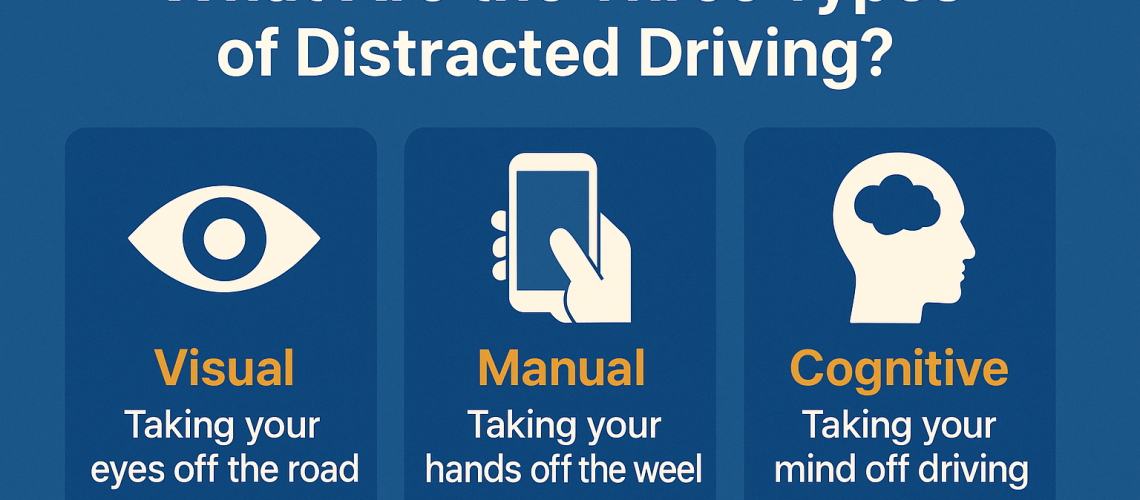Understanding the three types of distracted driving is essential for safe driving, especially for teen drivers or anyone who spends long hours behind the wheel. Every driver faces distractions, but recognizing them helps reduce crash risk and protect others on the road. Many learners first explore these topics when researching what is drivers ed or when looking into local programs like Alliance Driving School in San Diego.
Distracted driving is a hazard that continues to rise according to the NHTSA and the Department of Transportation. The CDC also reports how many people died in crashes each year due to driver distraction. Whether the distraction is visual, manual, or cognitive, each one can take a driver’s eyes off the road or pull their attention away from driving in ways that increase risk.
These three types of distracted driving are relevant to anyone studying driver behavior, preparing for a defensive course, or exploring beginner resources like driving tips for beginners. Below is a breakdown of the three main types of driving distractions and how each one impacts transportation safety.
Visual Distraction Eyes Off the Road
Visual distractions happen anytime a driver looks away from the road. This is one of the most common types of distracted driving because drivers often underestimate how quickly an accident can occur when their eyes move toward a screen or object. Even a slight veer into another lane can create a serious motor vehicle crash.
Looking at a cell phone, checking text messages, scanning a navigation system, or reading a GPS route are all visual driving distractions. Even looking at an accident on the side of the road or turning toward a passenger can take a driver’s eyes off the road for seconds. Research shows that looking away from the road even briefly can increase the chance of a crash.
Texting is one of the most dangerous visual distractions because it requires the driver to look down repeatedly. Cell phone use has become strongly regulated by texting laws due to its direct link to increased crash risk.
When new drivers begin studying what is defensive driving, they learn how visual distractions impact reaction time and situational awareness. Transportation experts consider visual distractions some of the most dangerous because they fully remove the driver’s ability to see hazards ahead.
Manual Distraction Hands Off the Wheel
Manual distraction happens anytime a driver takes one or both hands off the wheel. This type of distraction may feel harmless, but manual distraction disrupts control of the vehicle. Even minor actions can create driving hazards.
Common examples include eating and drinking, adjusting the radio, grabbing items from the seat, or interacting with a handheld device. These manual driving distractions reduce stability, delay reaction time, and increase the likelihood of a car accident.
A distracted driver who removes their hands off the wheel may struggle to steer quickly when facing a sudden hazard. Even reaching for a phone call or opening an email notification can pull a driver’s hands from the wheel long enough to cause a crash.
When learning how long is defensive driving course or how much is driving school, students often discover how manual distraction is one of the main topics covered in safety programs. It emphasizes that safe driving involves keeping hands on the steering wheel and minimizing unnecessary movement inside the vehicle.
Cognitive Distraction Mind Off Driving
Cognitive distraction occurs when a driver’s mind drifts away from the task of driving. Even if a driver appears focused visually, their attention may be somewhere else. This cognitive shift increases the risk of an accident because the brain cannot manage full awareness while distracted.
Examples include daydreaming, thinking about stressful events, listening deeply to the radio, or engaging in emotional conversations with a passenger. Fatigue and drowsy states can also heighten cognitive distraction. This type of distraction is especially dangerous because it is not always obvious to the driver.
Cognitive driving distractions often lead to delayed reactions, poor lane positioning, and difficulty predicting behaviors of others on the road. The NHTSA has documented how often cognitive distraction contributes to fatal motor vehicle crashes, highlighting its impact on traffic safety.
Students reviewing how often can you take defensive driving learn how cognitive distraction plays a major role in advanced safety training. It encourages drivers to manage stress, avoid multitasking, and keep their focus centered while behind the wheel.
Why Texting While Driving Is So Dangerous?
Texting and driving is considered the most dangerous form of distracted driving because it combines all three categories: visual, manual, and cognitive. When a driver texts, they look at their phone, take their hands off the wheel, and shift their mind away from driving. This triple distraction dramatically elevates crash risk.
According to the NHTSA, a driver who texts typically takes their eyes off the road for about five seconds. At 55 miles per hour, that is long enough to cover the length of a football field without seeing what is happening ahead. Many drivers underestimate how quickly a crash can happen under these conditions.
Texting while driving is also linked to increased risk for teen drivers, who are more likely to use a cell phone behind the wheel. The Department of Transportation and CDC continue to warn about texting and driving because too many people have died in crashes caused by this preventable behavior.
Even reading a message, trying to receive text alerts, or interacting with an email can take a driver’s eyes off the road long enough to cause a car accident.
How to Avoid Driving Distractions
Avoiding distraction is central to safe driving. A few small changes in behavior can significantly reduce crash risk and help drivers protect themselves and others on the road.
Use a Do Not Disturb mode
Use a Do Not Disturb mode on your cell phone so incoming text messages and phone calls do not tempt you away from driving. Many navigation systems allow pre set routes, so program your GPS before moving the vehicle.
Set your music playlist
before leaving home to avoid listening to the radio and switching stations while behind the wheel. Avoid eating and drinking to minimize manual distraction. Multitasking behind the wheel always creates hazard potential, so remain fully focused on the driving environment.
Defensive training programs and beginner learning materials like driving tips for beginners highlight how attention away from driving increases crash likelihood. Consistency in these habits supports long term safety.
What is the most dangerous type of distracted driving?
Texting is considered the most dangerous because it combines visual distraction, manual distraction, and cognitive distraction at once.
Is talking to passengers considered a distraction?
Yes, talking to a passenger can pull the driver’s mind off driving, creating cognitive distraction.
Why is multitasking behind the wheel unsafe?
Multitasking divides mental focus, delays reaction time, and increases the chance of an accident.





